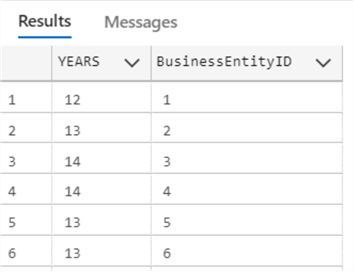By: Daniel Calbimonte
The DATEDIFF function returns the difference between two dates according to the datepart specified: such as year, day, month, etc.
Syntax
DATEDIFF(datepart, date1, date2)
Parameters
- datepart - This is the datepart to get the difference between the two dates. It can be a year (yy, yyyy), quarter (qq, q), month (mm, m), dayofyear(dy, y), day (dd, d), week (wk, ww), weekday (dw, w), hour (hh), minute (mi, n), second (ss, s), millisecond (ms), microsecond (mcs), nanosecond (ns). You can use the full name or the abbreviations in parenthesis.
- date1– Is the first date in the operation. This value can be a date or time.
- date2– Is the second date we want to use to compare with the first date. This value can be a date or time.
Simple DATEDIFF Example
The following example will show the number of years using the current date and March 11, 1979. If the dates were reversed, we would get a negative value.
SELECT DATEDIFF(year, '03-11-1979', CURRENT_TIMESTAMP) as yeardiff

Something to note is that DATEDIFF for year only takes the year part into consideration which was pointed out by one of the readers. So if we look at the example below this still returns 1, even though it has been less than 1 full year.
SELECT DATEDIFF(year, '02-01-2021', '01-01-2022') as yeardiff
DATEDIFF with NULL Values
If a NULL parameter is used the result will be NULL.
SELECT DATEDIFF(s, NULL, CURRENT_TIMESTAMP) as datediff

DATEDIFF Examples Using All Options
The next example will show the differences between two dates for each specific datapart and abbreviation. We will use the below date for the examples.
DECLARE @date datetime2 = '2021-01-07 14:36:17.6222691' DECLARE @date2 datetime2 = '2022-01-14 12:32:07.8494441'
| DateGroup | DatePart | Query | Result |
|---|---|---|---|
| day | d | SELECT DATEDIFF(d, @date, @date2) | 372 |
| day | day | SELECT DATEDIFF(day, @date, @date2) | 372 |
| day | dd | SELECT DATEDIFF(dd, @date, @date2) | 372 |
| dayofyear | dayofyear | SELECT DATEDIFF(dayofyear, @date, @date2) | 372 |
| dayofyear | dy | SELECT DATEDIFF(dy, @date, @date2) | 372 |
| dayofyear | y | SELECT DATEDIFF(y, @date, @date2) | 372 |
| hour | hh | SELECT DATEDIFF(hh, @date, @date2) | 8926 |
| hour | hour | SELECT DATEDIFF(hour, @date, @date2) | 8926 |
| microsecond | microsecond | SELECT DATEDIFF(microsecond, @date, @date2) | |
| microsecond | mcs | SELECT DATEDIFF(mcs, @date, @date2) | |
| millisecond | millisecond | SELECT DATEDIFF(millisecond, @date, @date2) | |
| millisecond | ms | SELECT DATEDIFF(ms, @date, @date2) | |
| minute | mi | SELECT DATEDIFF(mi, @date, @date2) | 535556 |
| minute | minute | SELECT DATEDIFF(minute, @date, @date2) | 535556 |
| minute | n | SELECT DATEDIFF(n, @date, @date2) | 535556 |
| month | m | SELECT DATEDIFF(m, @date, @date2) | 12 |
| month | mm | SELECT DATEDIFF(mm, @date, @date2) | 12 |
| month | month | SELECT DATEDIFF(month, @date, @date2) | 12 |
| nanosecond | nanosecond | SELECT DATEDIFF(nanosecond, @date, @date2) | |
| nanosecond | ns | SELECT DATEDIFF(ns, @date, @date2) | |
| quarter | q | SELECT DATEDIFF(q, @date, @date2) | 4 |
| quarter | SELECT DATEDIFF(qq, @date, @date2) | 4 | |
| quarter | quarter | SELECT DATEDIFF(quarter, @date, @date2) | 4 |
| second | s | SELECT DATEDIFF(s, @date, @date2) | 32133350 |
| second | second | SELECT DATEDIFF(second, @date, @date2) | 32133350 |
| second | ss | SELECT DATEDIFF(ss, @date, @date2) | 32133350 |
| week | week | SELECT DATEDIFF(week, @date, @date2) | 53 |
| week | wk | SELECT DATEDIFF(wk, @date, @date2) | 53 |
| week | ww | SELECT DATEDIFF(ww, @date, @date2) | 53 |
| weekday | dw | SELECT DATEDIFF(dw, @date, @date2) | 372 |
| weekday | w | SELECT DATEDIFF(w, @date, @date2) | 372 |
| weekday | weekday | SELECT DATEDIFF(weekday, @date, @date2) | 372 |
| year | year | SELECT DATEDIFF(year, @date, @date2) | 1 |
| year | yy | SELECT DATEDIFF(yy, @date, @date2) | 1 |
| year | yyyy | SELECT DATEDIFF(yyyy, @date, @date2) | 1 |
Note: for the items that were left blank created an overflow error as shown below.
DATEDIFF Function Resulted in an Overflow
The following example will display an error message.
SELECT DATEDIFF(millisecond, '02-11-1972', CURRENT_TIMESTAMP) as datediff, 'millisecond' as unit
The error message is the following:
This error occurs because there are too many milliseconds between 1972 until the current date.
Working with Table Data
The following example will show the number of years that the employee worked in a company based on the HireDate and they have worked there at least 10 years.
SELECT DATEDIFF(yy, HireDate, GETDATE()) as YEARS, BusinessEntityID FROM HumanResources.Employee WHERE DATEDIFF(yy, HireDate, GETDATE()) > 10

Related Articles
- SQL DATEADD
- How to Get Current Date in SQL Server
- Mimic timestamp behavior of other database platforms to store last modified date
- SQL Convert Date to YYYYMMDD
